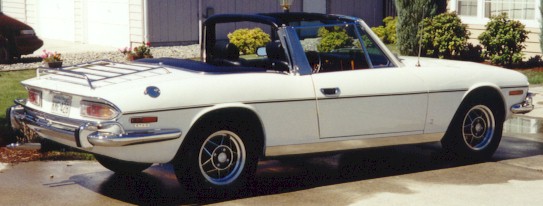
Home
Stag History
TR6 History
TR8 History
My Car Pictures
Images & Collectibles
Send me an eMAIL
Links
Stag.
A new kind of Triumph

The Stag was originally
conceived in the mid 1960's by Giovanni Michelotti. It
was from the successful six-cylinder Triumph 2000/2.5
saloon-car family that the Stag evolved. Michelotti
intended his smart convertible as a one-off "Motor
Show Special", for he built it on an old 2000 saloon
underframe. Once Triumph Director of Engineering Harry
Webster saw the finished product in Turin, he persuaded
his fellow directors that it should become a production
car and began to have it developed, but on a shortened
wheelbase. At that stage the Stag was intended to use a
2.5 litre fuel-injected six-cylinder engine like that of
the TR5/TR6 and launch was set for 1968.
At this same time, Triumph
was developing a new family of engines for use in the
1970's; a four-cylinder overhead camshaft unit (which was
eventually used in the Saab 99s, in Dolomite saloons, and
the TR7 sports car) and a V8 derivative which was
effectively two "fours" set at 90 degrees to
one another on a common crankshaft. The Stag
"six" was dropped in favor of the V8, which was
enlarged to 3 litres (with 145 bhp) and led to the
transmission, brakes, suspension and wheels all being
uprated to match. The Stag finally went on sale in the
autumn of 1970.
The Stag offered an
intriguing mixture of features: the V8 engine,
"smart" fashionable styling, true 2 + 2
seating, electric windows, padded roll bar, wide doors to
get in and out, easy to reach controls, reclining bucket
seats, detachable hard top with heated window, automatic
transmission, and air conditioning.
Unfortunately, the early
cars were none too reliable - in particular the engine
was prone to blowing cylinder gaskets and stretching
timing chains (both of which could lead to expensive
failures) - and the build quality was not satisfactory.
In the United States, in particular, word soon got around
that the Stag was not properly developed, and sales
slumped. It was finally withdrawn from the US market at
the end of 1973.
Although overdrive became
standard on manual transmission models in 1972, and there
were two packages of cosmetic improvements in 1973 and
1975 (the last including the standardization of cast
alloy road wheels and tinted glass), sales continued to
slide, and the Stag was finally dropped in 1977 after
25,877 had been produced.
The Stag V8 engine was
never used in any other Triumph or British Leyland model,
as the light-alloy Rover V8 proved to be cheaper to build
and more reliable to service. Even so, specialist are
today able to build thoroughly satisfactory Stag V8
engines, and there is a growing interest in the Grand
Touring car as a modern "classic".

The Stag was originally conceived in the mid 1960's by Giovanni Michelotti. It was from the successful six-cylinder Triumph 2000/2.5 saloon-car family that the Stag evolved. Michelotti intended his smart convertible as a one-off "Motor Show Special", for he built it on an old 2000 saloon underframe. Once Triumph Director of Engineering Harry Webster saw the finished product in Turin, he persuaded his fellow directors that it should become a production car and began to have it developed, but on a shortened wheelbase. At that stage the Stag was intended to use a 2.5 litre fuel-injected six-cylinder engine like that of the TR5/TR6 and launch was set for 1968.
At this same time, Triumph was developing a new family of engines for use in the 1970's; a four-cylinder overhead camshaft unit (which was eventually used in the Saab 99s, in Dolomite saloons, and the TR7 sports car) and a V8 derivative which was effectively two "fours" set at 90 degrees to one another on a common crankshaft. The Stag "six" was dropped in favor of the V8, which was enlarged to 3 litres (with 145 bhp) and led to the transmission, brakes, suspension and wheels all being uprated to match. The Stag finally went on sale in the autumn of 1970.
The Stag offered an intriguing mixture of features: the V8 engine, "smart" fashionable styling, true 2 + 2 seating, electric windows, padded roll bar, wide doors to get in and out, easy to reach controls, reclining bucket seats, detachable hard top with heated window, automatic transmission, and air conditioning.
Unfortunately, the early cars were none too reliable - in particular the engine was prone to blowing cylinder gaskets and stretching timing chains (both of which could lead to expensive failures) - and the build quality was not satisfactory. In the United States, in particular, word soon got around that the Stag was not properly developed, and sales slumped. It was finally withdrawn from the US market at the end of 1973.
Although overdrive became standard on manual transmission models in 1972, and there were two packages of cosmetic improvements in 1973 and 1975 (the last including the standardization of cast alloy road wheels and tinted glass), sales continued to slide, and the Stag was finally dropped in 1977 after 25,877 had been produced.
The Stag V8 engine was never used in any other Triumph or British Leyland model, as the light-alloy Rover V8 proved to be cheaper to build and more reliable to service. Even so, specialist are today able to build thoroughly satisfactory Stag V8 engines, and there is a growing interest in the Grand Touring car as a modern "classic".